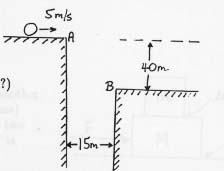Problem 3:
3)  Wile Y. Coyote (or is it the Roadrunner?) is running toward
a deep canyon at 5 m/s and goes over the edge at A. The canyon is
15 m wide and its opposite edge is 40 m lower than A.
Use g = 10 m/s2.
Wile Y. Coyote (or is it the Roadrunner?) is running toward
a deep canyon at 5 m/s and goes over the edge at A. The canyon is
15 m wide and its opposite edge is 40 m lower than A.
Use g = 10 m/s2.
a) Does he hit the canyon wall below B (Coyote) or the ground
beyond B (Roadrunner)?
b) How far from B does he hit?
Solution:
-
This is clearly an example of projectile motion. We know the initial
conditions, but we know only that he either lands at a specific
x-value or a specific y-value, but not which one. So, we need
to guess one, and see if it is correct.
- Let's guess that he lands on the ground beyond B. Now, choose
our coordinate system. I chose (x,y) = (0,0) as the
point A, x is positive to the right and y is positive upwards.
The equations of motion are (no acceleration in the x-direction!):
- x = x0 + v0xt
- and
- y = y0 + v0yt + ½at2
- where x0=0, y0=0, v0x = 5 m/s, v0y = 0 m/s, and a = -10 m/s2
- Setting y = -40 m (the location of the ground beyond B) the
y-equation gives
- - 40 m = ½(- 10 m/s2)t2
- solving this gives
- t = 2.83 s
- Now, we need to find if this is sufficient time to have reached
the other side of the canyon. We apply the x-equation
-
x = (5 m/s)(2.83 s) = 14.1 m
- which is less than the
canyon's 15 m width. Ouch - we guessed wrong, and
he must instead
hit the canyon wall somewhere below B. Clearly it must by
the Coyote, since the Roadrunner never misses a jump....
- To find out where he hits, we apply the projectile motion equations
again, but this time with the final x known to be 15 m:
- x = 15 m = v0xt
- or
- t = x/v0x = 15 m/(5 m/s) = 3 s
- stick this into the y-equation to see how far he has fallen by that
time:
- y = ½(- 10 m/s2)(3 s)2
= - 45 m
- This is
- (-40 m) - (-45 m) = 5 m below point B
Next Problem
Test 1
Physics 101 Home page
Physics Department Home Page
College of William and Mary,
Dept. of Physics
armd@physics.wm.edu
last updated: Oct 2 1998
 Wile Y. Coyote (or is it the Roadrunner?) is running toward
a deep canyon at 5 m/s and goes over the edge at A. The canyon is
15 m wide and its opposite edge is 40 m lower than A.
Use g = 10 m/s2.
Wile Y. Coyote (or is it the Roadrunner?) is running toward
a deep canyon at 5 m/s and goes over the edge at A. The canyon is
15 m wide and its opposite edge is 40 m lower than A.
Use g = 10 m/s2.
 Wile Y. Coyote (or is it the Roadrunner?) is running toward
a deep canyon at 5 m/s and goes over the edge at A. The canyon is
15 m wide and its opposite edge is 40 m lower than A.
Use g = 10 m/s2.
Wile Y. Coyote (or is it the Roadrunner?) is running toward
a deep canyon at 5 m/s and goes over the edge at A. The canyon is
15 m wide and its opposite edge is 40 m lower than A.
Use g = 10 m/s2.